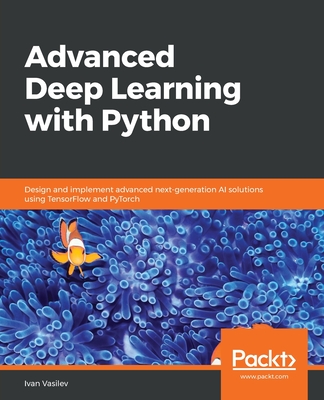Hands-On Mathematics for Deep Learning (Paperback)
Jay Dawani
- 出版商: Packt Publishing
- 出版日期: 2020-06-12
- 售價: $1,840
- 貴賓價: 9.5 折 $1,748
- 語言: 英文
- 頁數: 364
- 裝訂: Paperback
- ISBN: 1838647295
- ISBN-13: 9781838647292
-
相關分類:
DeepLearning
海外代購書籍(需單獨結帳)
買這商品的人也買了...
-
 $1,188Fedora 11 and Red Hat Enterprise Linux Bible (Paperback)
$1,188Fedora 11 and Red Hat Enterprise Linux Bible (Paperback) -
 離散數學 最新修訂版
離散數學 最新修訂版$800$632 -
 Python 設計模式深入解析 (Mastering Python Design Patterns)
Python 設計模式深入解析 (Mastering Python Design Patterns)$360$281 -
 演算法之美:隱藏在資料結構背後的原理 (C++版)
演算法之美:隱藏在資料結構背後的原理 (C++版)$650$507 -
 Discrete Mathematics and Its Applications, 8/e (Annotated Edition)(導讀本)
Discrete Mathematics and Its Applications, 8/e (Annotated Edition)(導讀本)$1,280$1,216 -
 $301Python 元學習 : 通用人工智能的實現 (Hands-On Meta Learning with Python: Meta learning using one-shot learning, MAML, Reptile, and Meta-SGD with TensorFlow)
$301Python 元學習 : 通用人工智能的實現 (Hands-On Meta Learning with Python: Meta learning using one-shot learning, MAML, Reptile, and Meta-SGD with TensorFlow) -
 PowerShell 流程自動化攻略 (Powershell for Sysadmins: A Hands-On Guide to Automating Your Workflow)
PowerShell 流程自動化攻略 (Powershell for Sysadmins: A Hands-On Guide to Automating Your Workflow)$500$395 -
 軟體架構原理|工程方法 (Fundamentals of Software Architecture: A Comprehensive Guide to Patterns, Characteristics, and Best Practices)
軟體架構原理|工程方法 (Fundamentals of Software Architecture: A Comprehensive Guide to Patterns, Characteristics, and Best Practices)$680$537 -
 精通資料視覺化 : 用試算表與程式說故事 (Hands-On Data Visualization: Interactive Storytelling from Spreadsheets to Code)
精通資料視覺化 : 用試算表與程式說故事 (Hands-On Data Visualization: Interactive Storytelling from Spreadsheets to Code)$680$537 -
 打下最紮實 AI 基礎不依賴套件:手刻機器學習神經網路穩健前進
打下最紮實 AI 基礎不依賴套件:手刻機器學習神經網路穩健前進$1,200$948 -
 Probabilistic Machine Learning: An Introduction (Hardcover)
Probabilistic Machine Learning: An Introduction (Hardcover)$2,650$2,597 -
 強健的 Python|撰寫潔淨且可維護的程式碼 (Robust Python: Write Clean and Maintainable Code)
強健的 Python|撰寫潔淨且可維護的程式碼 (Robust Python: Write Clean and Maintainable Code)$680$537 -
 Template Metaprogramming with C++: Learn everything about C++ templates and unlock the power of template metaprogramming (Paperback)
Template Metaprogramming with C++: Learn everything about C++ templates and unlock the power of template metaprogramming (Paperback)$1,900$1,805 -
 邁向 Linux 工程師之路:Superuser 一定要懂的技術與運用, 3/e (How Linux Works : What Every Superuser Should Know, 3/e)
邁向 Linux 工程師之路:Superuser 一定要懂的技術與運用, 3/e (How Linux Works : What Every Superuser Should Know, 3/e)$780$608 -
 精通無瑕程式碼:工程師也能斷捨離!消除複雜度、提升效率的 17個關鍵技法 (The Art of Clean Code: Best Practices to Eliminate Complexity and Simplify Your Life)
精通無瑕程式碼:工程師也能斷捨離!消除複雜度、提升效率的 17個關鍵技法 (The Art of Clean Code: Best Practices to Eliminate Complexity and Simplify Your Life)$600$468 -
 Neural Networks and Deep Learning: A Textbook, 2/e (Hardcover)
Neural Networks and Deep Learning: A Textbook, 2/e (Hardcover)$2,800$2,660 -
 Frida Android SO 逆向深入實踐
Frida Android SO 逆向深入實踐$894$849 -
 $421CPU 眼裡的 C/C++
$421CPU 眼裡的 C/C++ -
 Industrial Vision Systems with Raspberry Pi: Build and Design Vision Products Using Python and Opencv (Paperback)
Industrial Vision Systems with Raspberry Pi: Build and Design Vision Products Using Python and Opencv (Paperback)$2,280$2,166 -
 Engineering Mathematics
Engineering Mathematics$1,000$950 -
 Rust 最佳入門與實戰
Rust 最佳入門與實戰$1,000$790 -
 自己開發 ChatGPT - LLM 從頭開始動手實作
自己開發 ChatGPT - LLM 從頭開始動手實作$720$568 -
 零基礎快速入行入職軟件測試工程師, 2/e
零基礎快速入行入職軟件測試工程師, 2/e$479$455 -
 分佈式機器學習模式
分佈式機器學習模式$419$398 -
 手機感測器也上 AI – 人工智慧邊緣運算實作開發教戰手冊
手機感測器也上 AI – 人工智慧邊緣運算實作開發教戰手冊$1,080$853
商品描述
Key Features
- Understand linear algebra, calculus, gradient algorithms, and other concepts essential for training deep neural networks
- Learn the mathematical concepts needed to understand how deep learning models function
- Use deep learning for solving problems related to vision, image, text, and sequence applications
Book Description
Most programmers and data scientists struggle with mathematics, having either overlooked or forgotten core mathematical concepts. This book uses Python libraries to help you understand the math required to build deep learning (DL) models.
You'll begin by learning about core mathematical and modern computational techniques used to design and implement DL algorithms. This book will cover essential topics, such as linear algebra, eigenvalues and eigenvectors, the singular value decomposition concept, and gradient algorithms, to help you understand how to train deep neural networks. Later chapters focus on important neural networks, such as the linear neural network and multilayer perceptrons, with a primary focus on helping you learn how each model works. As you advance, you will delve into the math used for regularization, multi-layered DL, forward propagation, optimization, and backpropagation techniques to understand what it takes to build full-fledged DL models. Finally, you'll explore CNN, recurrent neural network (RNN), and GAN models and their application.
By the end of this book, you'll have built a strong foundation in neural networks and DL mathematical concepts, which will help you to confidently research and build custom models in DL.
What you will learn
- Understand the key mathematical concepts for building neural network models
- Discover core multivariable calculus concepts
- Improve the performance of deep learning models using optimization techniques
- Cover optimization algorithms, from basic stochastic gradient descent (SGD) to the advanced Adam optimizer
- Understand computational graphs and their importance in DL
- Explore the backpropagation algorithm to reduce output error
- Cover DL algorithms such as convolutional neural networks (CNNs), sequence models, and generative adversarial networks (GANs)
Who this book is for
This book is for data scientists, machine learning developers, aspiring deep learning developers, or anyone who wants to understand the foundation of deep learning by learning the math behind it. Working knowledge of the Python programming language and machine learning basics is required.
作者簡介
Jay Dawani is a former professional swimmer turned mathematician and computer scientist. He is also a Forbes 30 Under 30 Fellow. At present, he is the Director of Artificial Intelligence at Geometric Energy Corporation (NATO CAGE) and the CEO of Lemurian Labs - a startup he founded that is developing the next generation of autonomy, intelligent process automation, and driver intelligence. Previously he has also been the technology and R&D advisor to Spacebit Capital. He has spent the last three years researching at the frontiers of AI with a focus on reinforcement learning, open-ended learning, deep learning, quantum machine learning, human-machine interaction, multi-agent and complex systems, and artificial general intelligence.
目錄大綱
- Linear Algebra
- Vector Calculus
- Probability and Statistics
- Optimization
- Graph Theory
- Linear Neural Networks
- Feedforward Neural Networks
- Regularization
- Convolutional Neural Networks
- Recurrent Neural Networks
- Attention Mechanisms
- Generative Models
- Transfer and Meta Learning
- Geometric Deep Learning










